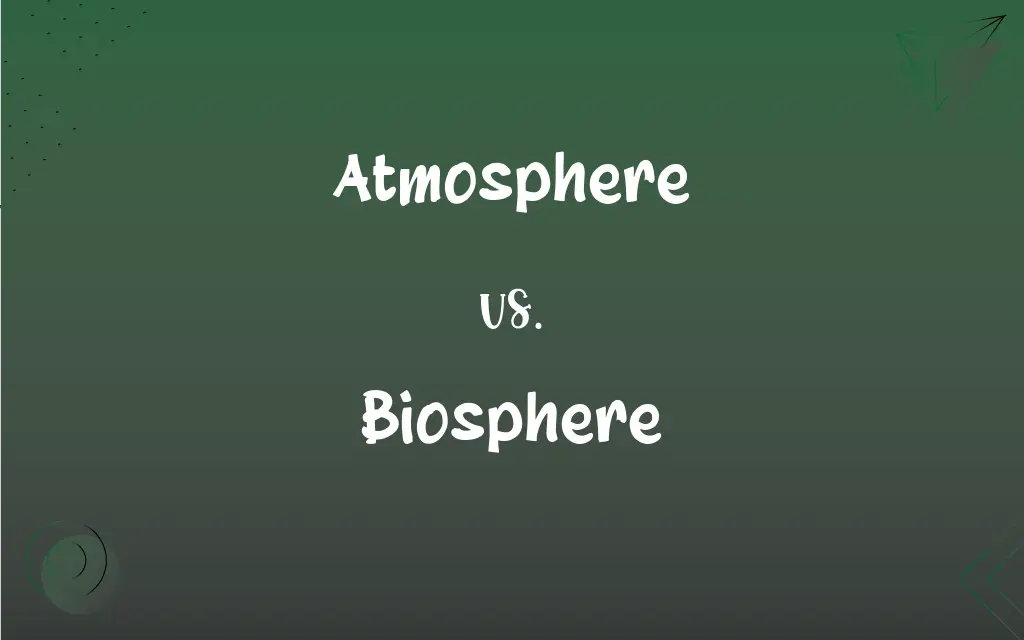Atmosphere vs. Biosphere: What's the Difference?
By Janet White || Updated on October 19, 2023
"Atmosphere" is the layer of gases surrounding Earth, while "Biosphere" encompasses all ecosystems and living organisms on Earth and in the atmosphere.

Key Differences
"Atmosphere" refers to the layers of gas that envelop the Earth, protecting it and enabling life. It's composed primarily of nitrogen and oxygen, with smaller amounts of other gases, and extends up to 10,000 km above the Earth's surface. In contrast, the "Biosphere" is the global sum of all ecosystems, a closed system (except for solar and cosmic radiation), and contains all living beings and their relationships, including their interaction with the elements of the lithosphere, hydrosphere, and atmosphere.
The "atmosphere" plays a crucial role in the protection of life on Earth. It absorbs solar radiation, holds essential gases, and maintains temperature to a life-sustaining degree. Without the atmosphere, life as we know it would not exist. On the other hand, the "biosphere" is where living organisms exist and interact with one another and their surroundings. It extends from the deepest root systems of trees to the dark environment of ocean floors, and even into the atmosphere itself.
The "atmosphere" is categorized into various layers, each with distinct characteristics, temperatures, and chemical compositions. These layers, including the troposphere, stratosphere, mesosphere, thermosphere, and exosphere, serve functions that sustain life on Earth. Conversely, the "biosphere" is divided into several biomes, which are major community groupings of plants and animals, each adapted to specific environments, such as deserts, rainforests, and tundras.
The importance of the "atmosphere" cannot be overstated; it's crucial for weather systems, the water cycle, and regulating Earth's climate. It's where meteorological events, like storms, precipitation, and winds, occur. Meanwhile, the "biosphere" is equally important, as it contains all the known ingredients necessary for life, and its health directly impacts the quality and sustainability of life on Earth.
Scientific disciplines related to the "atmosphere" include meteorology and climatology, as they study atmospheric processes, weather, and climate. In parallel, disciplines connected with the "biosphere" include biology, ecology, and environmental science, focusing on living organisms and their environments.
ADVERTISEMENT
Comparison Chart
Composition
Gases (nitrogen, oxygen, etc.)
All living beings and their environments
Function
Protects Earth, sustains life
Habitat for all living organisms
Scope
Extends up to 10,000 km above Earth
Ranges from deep ocean floors to high in the atmosphere
Study
Meteorology, climatology
Biology, ecology, environmental science
Role
Weather, climate regulation
Life sustainability, biodiversity
ADVERTISEMENT
Atmosphere and Biosphere Definitions
Atmosphere
The gaseous envelope surrounding the Earth.
The planet's atmosphere is crucial for sustaining life.
Biosphere
The regions of the surface and atmosphere of the Earth occupied by living organisms.
Climate change affects every level of the biosphere.
Atmosphere
A unit of pressure used in meteorology.
The barometer measures atmospheric pressure in atmospheres.
Biosphere
A closed, self-regulating system of ecosystems.
The introduction of invasive species disrupts the balance of the biosphere.
Atmosphere
The gaseous mass or envelope surrounding a celestial body, especially the one surrounding the earth, and retained by the celestial body's gravitational field.
Biosphere
A scientific term describing the entirety of Earth's ecosystems.
Scientists study the biosphere to understand biodiversity.
Atmosphere
The air or climate in a specific place.
Biosphere
The sum total of different habitats on Earth capable of supporting life.
The deep sea is a mysterious part of the biosphere.
Atmosphere
Abbr. atm Physics A unit of pressure equal to the air pressure at sea level. It equals the amount of pressure that will support a column of mercury 760 millimeters high at 0 degrees Celsius under standard gravity, or 14.7 pounds per square inch (1.01325 × 105 pascals).
Biosphere
The global ecological system integrating all living beings and their relationships.
Human activities have significant impacts on the biosphere.
Atmosphere
A dominant intellectual or emotional environment or attitude
An atmosphere of distrust among the electorate.
Biosphere
The part of the earth and its atmosphere in which living organisms exist or that is capable of supporting life.
Atmosphere
The dominant tone or mood of a work of art.
Biosphere
The living organisms and their environment composing the biosphere.
Atmosphere
An aesthetic quality or effect, especially a distinctive and pleasing one, associated with a particular place
A restaurant with an Old World atmosphere.
Biosphere
The part of the Earth and its atmosphere capable of supporting life.
Atmosphere
The gases surrounding the Earth or any astronomical body.
Biosphere
The totality of living organisms and their environment.
Atmosphere
The air in a particular place.
Biosphere
The regions of the surface and atmosphere of the Earth (or other planet) where living organisms exist
Atmosphere
The conditions (such as music, illumination etc.) that can influence the mood felt in an environment.
Atmosphere
The apparent mood felt in an environment.
Atmosphere
A unit of measurement for pressure equal to 101325 Pa (symbol: atm)
Atmosphere
Extras in a scene who have no spoken lines.
Atmosphere
The whole mass of aëriform fluid surrounding the earth; - applied also to the gaseous envelope of any celestial orb, or other body; as, the atmosphere of Mars.
An atmosphere of cold oxygen.
Atmosphere
A supposed medium around various bodies; as, electrical atmosphere, a medium formerly supposed to surround electrical bodies.
Atmosphere
The pressure or weight of the air at the sea level, on a unit of surface, or about 14.7 lbs. to the sq. inch.
Hydrogen was liquefied under a pressure of 650 atmospheres.
Atmosphere
Any surrounding or pervading influence or condition.
The chillest of social atmospheres.
Atmosphere
The portion of air in any locality, or affected by a special physical or sanitary condition; as, the atmosphere of the room; a moist or noxious atmosphere.
Atmosphere
A particular environment or surrounding influence;
There was an atmosphere of excitement
Atmosphere
A unit of pressure: the pressure that will support a column of mercury 760 mm high at sea level and 0 degrees centigrade
Atmosphere
The mass of air surrounding the Earth;
There was great heat as the comet entered the atmosphere
It was exposed to the air
Atmosphere
The weather or climate at some place;
The atmosphere was thick with fog
Atmosphere
The envelope of gases surrounding any celestial body
Atmosphere
A distinctive but intangible quality surrounding a person or thing;
An air of mystery
The house had a neglected air
An atmosphere of defeat pervaded the candidate's headquarters
The place had an aura of romance
Atmosphere
The air in any particular place.
We could feel the tension in the atmosphere of the room.
Atmosphere
The mood or pervasive quality of a situation.
The event had a festive atmosphere.
Atmosphere
The general environment or setting.
The new legislation created a positive atmosphere for investors.
FAQs
What are the main layers of the atmosphere?
Troposphere, stratosphere, mesosphere, thermosphere, exosphere.
What are biomes in the context of the biosphere?
They're specific regions like deserts, forests, and oceans.
What primarily composes the atmosphere?
It's mainly composed of nitrogen and oxygen.
What is the biosphere’s relation to life on Earth?
It includes all life and the environments it inhabits.
How high does the atmosphere extend?
Up to about 10,000 km above Earth's surface.
Can the atmosphere protect us from space hazards?
It shields Earth from solar radiation and small meteors.
How does the biosphere sustain life?
Through complex interactions between organisms and their environments.
Are humans part of the biosphere?
Yes, they're an integral component.
Does the biosphere include water bodies?
Yes, it encompasses all ecosystems, including aquatic.
Are there boundaries to the atmosphere?
It gradually thins until it merges with outer space.
Can changes in the biosphere affect climate?
Yes, significantly, especially through the carbon cycle.
How does the atmosphere affect weather?
It's where weather patterns and systems develop.
What gases are minor but crucial in the atmosphere?
Argon, carbon dioxide, and various noble gases.
Is the atmosphere important for climate?
Yes, it's crucial for regulating Earth's climate.
Is the biosphere affected by human activity?
Significantly, through actions like deforestation and pollution.
What field studies the atmosphere?
Meteorology and climatology.
Are there man-made biospheres?
Yes, artificial closed ecosystems, like Biosphere 2.
Is the biosphere static?
No, it's ever-changing and evolving.
Why is the atmosphere essential for life?
It provides essential gases, maintains temperature, and protects from harmful radiation.
How is biodiversity related to the biosphere?
Biodiversity is the variety of life within the biosphere.
About Author
Written by
Janet WhiteJanet White has been an esteemed writer and blogger for Difference Wiki. Holding a Master's degree in Science and Medical Journalism from the prestigious Boston University, she has consistently demonstrated her expertise and passion for her field. When she's not immersed in her work, Janet relishes her time exercising, delving into a good book, and cherishing moments with friends and family.































































